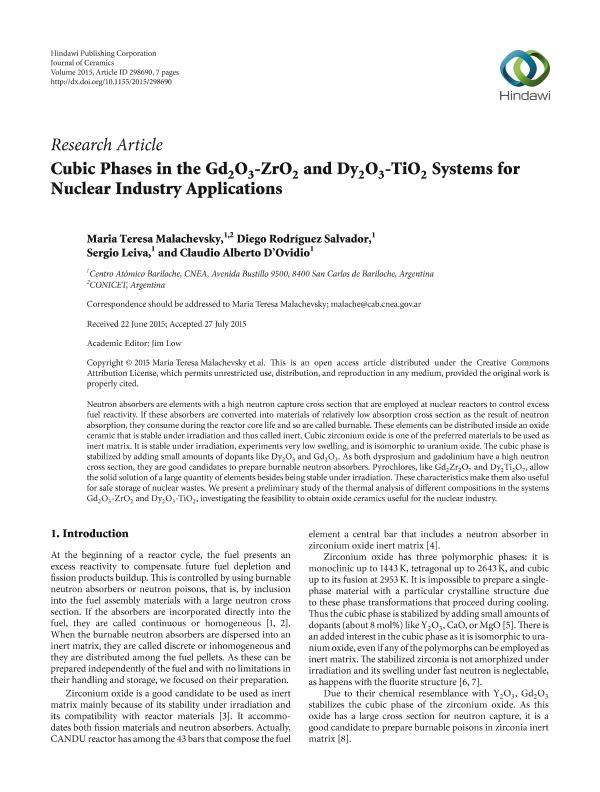Mostrar el registro sencillo del ítem
dc.contributor.author
Malachevsky, Maria Teresa

dc.contributor.author
Rodríguez Salvador, Diego

dc.contributor.author
Leiva, Sergio

dc.contributor.author
D'Ovidio, Claudio Alberto
dc.date.available
2018-08-10T20:18:49Z
dc.date.issued
2015-08
dc.identifier.citation
Malachevsky, Maria Teresa; Rodríguez Salvador, Diego; Leiva, Sergio; D'Ovidio, Claudio Alberto; Cubic Phases in the Gd2O3-ZrO2 and Dy2O3-TiO2 Systems for Nuclear Industry Applications; Hindawi Publishing Corporation; Journal of Ceramics; 2015; 8-2015; 1-7; 298690
dc.identifier.issn
2090-8628
dc.identifier.uri
http://hdl.handle.net/11336/55003
dc.description.abstract
Neutron absorbers are elements with a high neutron capture cross section that are employed at nuclear reactors to control excess fuel reactivity. If these absorbers are converted into materials of relatively low absorption cross section as the result of neutron absorption, they consume during the reactor core life and so are called burnable. These elements can be distributed inside an oxide ceramic that is stable under irradiation and thus called inert. Cubic zirconium oxide is one of the preferred materials to be used as inert matrix. It is stable under irradiation, experiments very low swelling, and is isomorphic to uranium oxide. The cubic phase is stabilized by adding small amounts of dopants like Dy2O3 and Gd2O3. As both dysprosium and gadolinium have a high neutron cross section, they are good candidates to prepare burnable neutron absorbers. Pyrochlores, like Gd2Zr2O7 and Dy2Ti2O7, allow the solid solution of a large quantity of elements besides being stable under irradiation. These characteristics make them also useful for safe storage of nuclear wastes. We present a preliminary study of the thermal analysis of different compositions in the systems Gd2O3-ZrO2 and Dy2O3-TiO2, investigating the feasibility to obtain oxide ceramics useful for the nuclear industry.
dc.format
application/pdf
dc.language.iso
eng
dc.publisher
Hindawi Publishing Corporation

dc.rights
info:eu-repo/semantics/openAccess
dc.rights.uri
https://creativecommons.org/licenses/by-nc-sa/2.5/ar/
dc.subject
Neutron Poison
dc.subject
Inert Matrix
dc.subject
Ceramic Absorbers
dc.subject.classification
Recubrimientos y Películas

dc.subject.classification
Ingeniería de los Materiales

dc.subject.classification
INGENIERÍAS Y TECNOLOGÍAS

dc.title
Cubic Phases in the Gd2O3-ZrO2 and Dy2O3-TiO2 Systems for Nuclear Industry Applications
dc.type
info:eu-repo/semantics/article
dc.type
info:ar-repo/semantics/artículo
dc.type
info:eu-repo/semantics/publishedVersion
dc.date.updated
2018-08-08T14:15:15Z
dc.journal.volume
2015
dc.journal.pagination
1-7; 298690
dc.journal.pais
Egipto

dc.journal.ciudad
El Cairo
dc.description.fil
Fil: Malachevsky, Maria Teresa. Comisión Nacional de Energía Atómica. Centro Atómico Bariloche; Argentina. Consejo Nacional de Investigaciones Científicas y Técnicas; Argentina
dc.description.fil
Fil: Rodríguez Salvador, Diego. Comisión Nacional de Energía Atómica. Centro Atómico Bariloche; Argentina. Consejo Nacional de Investigaciones Científicas y Técnicas; Argentina
dc.description.fil
Fil: Leiva, Sergio. Comisión Nacional de Energía Atómica. Centro Atómico Bariloche; Argentina
dc.description.fil
Fil: D'Ovidio, Claudio Alberto. Comisión Nacional de Energía Atómica. Centro Atómico Bariloche; Argentina
dc.journal.title
Journal of Ceramics
dc.relation.alternativeid
info:eu-repo/semantics/altIdentifier/doi/http://dx.doi.org/10.1155/2015/298690
dc.relation.alternativeid
info:eu-repo/semantics/altIdentifier/url/https://www.hindawi.com/journals/jceram/2015/298690/
Archivos asociados
